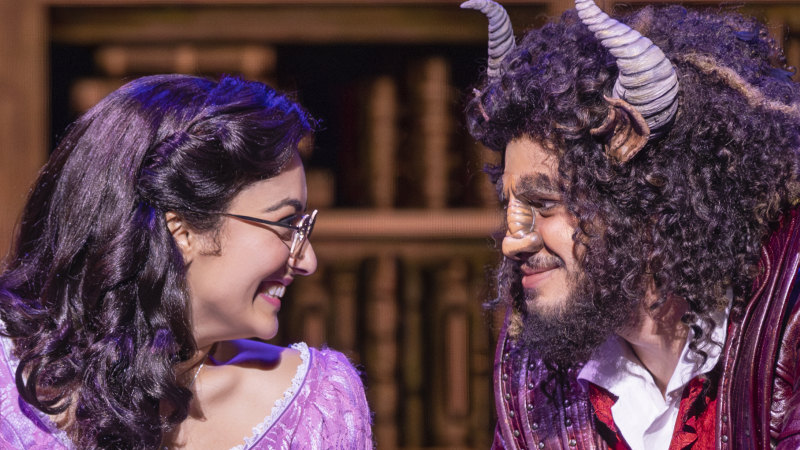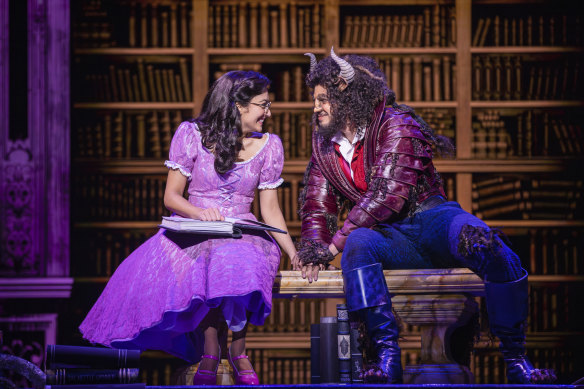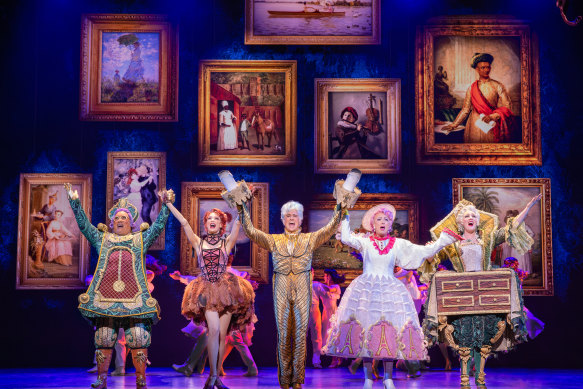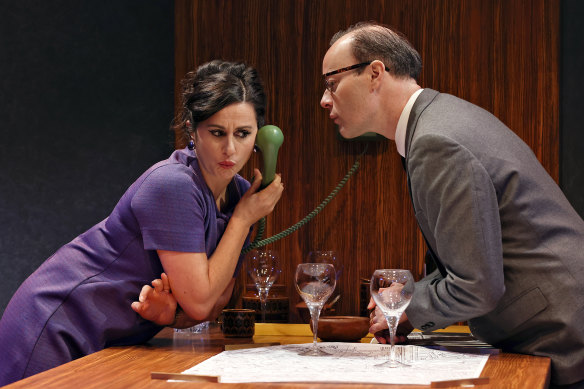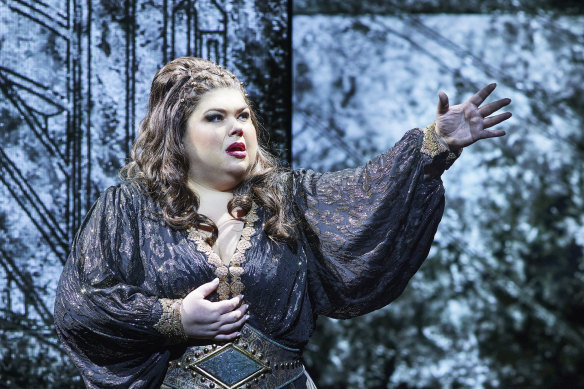Save articles for later
Add articles to your saved list and come back to them any time.
MUSICAL THEATRE
Beauty and the Beast ★★★★
Capitol Theatre, until December 24
So you think you’ve seen some coups de theatre in your time? Think again. Beauty and the Beast dusts the eyes with implausible visual magic and theatrical sleight-of-hand that very effectively disguises the show’s imperfections. Even those dragged along by their insistent eight-year-old daughter – those who might grumble in advance about the puerile subject and chintzy Disney – will be amazed to find themselves enthralled by what happens when bursting imaginations, brilliant technicians and vast budgets collide.
Stanley A. Meyer’s scenic design is a wonder-world fully integrating old-fashioned backdrops, enchanting three-dimensional sets and startling projections. Ann Hould-Ward’s costumes are more than a match, with Belle’s sparkly yellow gown getting its own round of applause. But then this show was like a circus in terms of how often the audience started clapping, including a spontaneous standing ovation during Act One.
Shubshri Kandiah and Brendan Xavier star as Beauty and the Beast.Credit: Daniel Boud
The essence of the story, said to be thousands of years old, was distilled into the tale we recognise nearly 300 years ago. Several film versions predated Disney’s 1991 animated feature, before the same company hit Broadway in 1994 with this musical penned by Alan Menken (music), Howard Ashman and Tim Rice (lyrics), and Linda Woolverton (book). Directed and choreographed by Matt West, that production now returns to Sydney for the first time since 1996.
West’s witty, exuberant and even breathtaking choreography is supremely realised by a local cast that’s led by Shubshri Kandiah as Belle, the Beauty of the title. Three months ago Kandiah was Cinderella in Belvoir’s brilliant production of Sondheim’s Into the Woods, and the characters are not dissimilar: an ingenue with a heart of gold who’s much smarter than all those who would manipulate her.
Kandiah charms with her presence, the lightness of her acting and the quality of her voice – even if her singing brings us to one of the show’s aforementioned imperfections.
Menken’s score is an old-world Broadway melange with precursors stretching from the 1920s all the way through to the 1960s and A Funny Thing Happened on the Way to the Forum, but the songs fall into two camps: the dazzlingly engaging comic numbers and the rest. Alas, when Belle or the Beast (Brendan Xavier) must sing of their emotions, all the playfulness and nuance seems to fly out the latticed window, leaving much heaving of bosoms, hitting of high notes and swelling of orchestrations, but with all the sound and fury signifying very little.
Xavier acquits himself well, although it’s a role that’s somewhat thankless. For most of the show his Beast is sulking, hulking, thick, wrathful and monosyllabic, and the character would hardly have lost the eight-year-olds in the audience had he been drawn with a smidge more complexity.
By contrast, the fullness of the minor characters is a strength, led by Gaston, the posturing village strongman (who thinks Belle is rightfully his just because he desires her), amusingly played by Andy Cook. Sustaining the laughs are Rohan Browne as Lumiere, Gareth Jacobs as Cogsworth, Jayde Westaby as Mrs Potts, Hayley Martin as Babette and the rest of the substantial cast. The ensemble work is flawless, as is the surround-sound and the orchestra directed by Luke Hunter.
The musical features an impressive supporting cast, who almost steal the show.Credit: Daniel Boud
The story’s enduring appeal and pertinence is that the Beast’s “otherness” ultimately does not prevent Belle falling for him. Belle, meanwhile, has all the snowflake purity of the fairytale, while also being sharp, brave and in complete command of her destiny – not a bad role model for those enraptured eight-year-olds.
Reviewed by John Shand
THEATRE
Benefactors ★★★½
Ensemble Theatre, until July 22
Up-and-coming architect David is tasked with transforming an inner-city slum into a modern housing scheme but, as the project makes its way through the grinding machinations of local government, his hopes to create a better way to live fall foul of cost cutting and stakeholder demands. What’s new?
Benefactors is a dazzling puzzle of a play. Not in its subject matter: that’s as old as time and playwriting. Michael Frayn’s four-hander, written in 1984 and awarded Olivier and New York Drama Critics’ Circle Awards, is ultimately about human nature and dreams, and how dreams often end up circling the plughole. The real puzzle comes in the way Frayn unravels the story, backwards and forwards in time, in and out of memories, pieced together in vivid episodes heightened by the 20:20 lens of hindsight.
Emma Palmer and Gareth Davies star as Jane and David in Benefactors.Credit: Prudence Upton
It’s a brave – some might even say foolhardy – choice by Ensemble artistic director Mark Kilmurry. But his cast is all in, totally committed to the densely packed language and the deeply English turn of phrase, making Frayn’s heightened, byzantine dialogue seem almost natural. On opening night the laughs come in abrupt, unpredictable and sometimes inexplicable waves, with some of the darkest humour passing by unremarked.
The lynch-pin in a strong cast is Emma Palmer, brilliant as capable Jane, the one who makes the dinners, pours the drinks and remembers how it all unravelled with steadfast acuity. Gareth Davies, as David, dances the delicate dance of a man losing his integrity, piece by painful piece, and Matt Minto, as Colin, is a diligent wrecker on the side of chaos, wherever that might be. As for his wife Sheila (Megan Drury), she undergoes the biggest transformation, from naive ineptitude to surprised competence.
The production, designed by Nick Fry, centres on a kitchen worktop, on which the plans for David’s inner-city transformation are rolled out, scratched out, torn up; and on which endless cups of coffee and glasses of wine are poured.
Curiously, Kilkenny leaves the company to mime the pouring and drinking, and even the unceremonious throwing of a dish of stew, hot enough to send Colin to seek medical help. The miming goes on until the last scene, where David and Jane pour a glass of all too red wine and, suddenly, it’s real. We’re here. Benefactors is now.
Reviewed by Harriet Cunningham
OPERA
Aida ★★★★
Opera House Joan Sutherland Theatre, until July 21
Davide Livermore’s production of Verdi’s Aida, with sets by Gio Forma and digital design by D-Wok, replaces the triumphal pageantry traditionally accompanying this work with hyperreal digital images that appear and dissolve on mobile screens like scenes in a fantasy video.
Metallic snakes slither, blood-red clouds swirl and lightning flashes over moonlit water. Savage beasts, Egyptian figures in profile and a naked goddess with a swelling belly look on, all possessed of a disturbing hypnotic stare. These digital images create their own tension, alongside the eternal, irreconcilable conflict of love and loyalty that Verdi develops with such mastery.
Leah Crocetto stars as Ethiopian princess Aida in this Opera Australia production.Credit: Keith Saunders
Leah Crocetto as Aida has a voice of enveloping power and warmth, sustaining the soliloquy of act one with colour and expressively moulded line, soaring magisterially over the chorus and orchestra in the triumphal march in act two.
Elena Gabouri, as her rival Amneris, has a voice of firmer edge, effective in moments of high drama. She sang her climactic scene with tragic force, maintaining strength both in clamouring high notes and in guttural tones in the low register.
As ill-fated hero Radames, Najmiddin Mavlyanov had the most naturally attractive voice of the cast, with nutty-brown richness and sinuous intensity that was not overdone so that it retained a fresh bloom.
By contrast, Warwick Fyfe, as Aida’s father, the defeated Ethiopian king Amonasro, bristled with energy and fierce defiance.
Roberto Scandiuzzi as the vengeful high priest Ramfis had a forceful textured sound, haughty and imposing. As the King, David Parkin sang with a leaner, penetrating tone.
The duets of this opera are crucial to the unfolding of the narrative’s central conflicts. Nurtured by subtly insistent flexibility of tempo from conductor Stuart Stratford, the various pairings between the three principals, Crocetto, Gabouri and Mavlyanov, sustained taut engagement through balance and strength of musical shape.
As well as the splendour of the victory scene in act two, with radiant trumpet choirs from the high galleries, the Opera Australia Orchestra under Stratford brought out the nuanced originality of the quieter moments of Verdi’s score.
The Opera Australia Chorus in turn swelled resonantly, laughed playfully and prayed reverently, always with glowing texture and high professionalism.
Much of the weight of the battle and victory is taken by a group of women dancers who, under Allie Graham’s choreography for this revival, combined grace with convulsiveness, agility and aggression.
Reviewed by Peter McCallum
Sydney Morning Herald subscribers can enjoy 2-for-1 tickets* to the Archibald, Wynne and Sulman Prizes exhibition at the Art Gallery of New South Wales during June 2023. Click here for more details.
Find out the next TV, streaming series and movies to add to your must-sees. Get The Watchlist delivered every Thursday.
Most Viewed in National
From our partners
Source: Read Full Article
